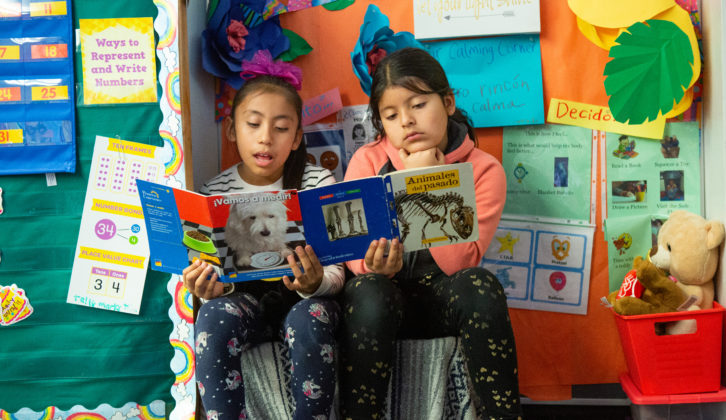Learning recovery: Helping students find their way back
Tackling learning recovery after so much time without in-person school can be an imposing mountain for students and teachers alike. Now more than ever, teaching has become “a moving landscape” that requires on-the-fly solutions or adaptation, Kanoe Namahoe, SmartBrief’s editorial director for education. She facilitated the company’s recent “Learning Recovery: Helping Students Find Their Way Back” webinar, where she was joined by Morgan State University associate professor Christian Anderson, who works in the department of teacher education and professional development, and Rosemary Anderson, a licensed mental health practitioner and consultant in private practice (and Christian’s wife).
We’ve shared portions of the webinar here, edited for length and clarity.
Accelerated learning
Question: What is accelerated learning, and what models can help?
Answer: When you think about accelerated learning, you’re thinking about ways to assess the students to move them forward quicker. Since the pandemic, however, educators are really defining accelerating learning as catching students upon learning that didn’t happen well, or at all, over six to 18 months, Christian said.
Educators usually choose between two methods. In curriculum compacting, you take similar content and clusters of learning standards and objectives and teach them inclusively together to cover more material. Christian said that accelerated time is the other option — adding more time for math instruction beyond the typical 60 minutes per day to give students more dedicated time with the material.
Student fatigue
Question: Is there any concern about student fatigue or overload if you’re jumping from 60 or 90 minutes to 120 minutes? What do students need in order to be successful with accelerated learning and learning recovery?
Answer: “That’s a big concern. It really depends on the school system, and the master schedule of the school,” Christian said. Ideally, those extra minutes are spread out across the week.
Rosemary took a broader view: “I always say adults need to recognize what our journey has been through COVID and recognize that a child who developmentally is working on moving from concrete to abstract thinking experienced COVID very differently than we did based on the developmental age, intellectual ability, etc. Sometimes, it’s still a parallel process for us to also take a step back and say, ‘Hey, we’re not going to jump back into business as usual. We went through a very traumatic, life-moving experience, and we need to be able to have the time to allow the neural pathways to be reconfigured in a way that our routines, our procedures and the way we move through life is re-patterned and reorganized in this new normal.’ ”
Rosemary also cautioned educators to “be very careful of the achievement culture and what happens with groupthink — with the group thinking in one way and discouraging creativity and individual responsibility. We have to be very mindful of that in terms of how administrators and teachers have discussions about evaluating academic success for a particular student or particular student groups,” Rosemary adds.
“I think one of the things that’s important is this idea of redefining student success and understanding that we want students to have social-emotional competencies. We want students to have strong verbal and nonverbal communication, to be able to communicate all of their needs, including appropriately communicating their emotional needs. And we want students to be high achievers as indicated in grade or test performance. But we also want students to have room to exercise their creativity.”
Gifted students
Question: How has all of this manifested with gifted and talented students, especially the ones who have high expectations of themselves?
Answer: Many of Rosemary’s clients are gifted and talented students, and they tell her that “many times, they need the opportunity to re-enter academic rigor, not from the place that was pre-COVID but from the now. They’re jumping into academic environments where the pressure is dialed up to accelerate learning to catch up, and that is not proving to be the most advantageous and is really causing anxiety and depression to go up. What they’ll say to me is that it’s actually reducing academic motivation.”
Teachers tell Rosemary that’s exactly what they’re seeing in gifted and talented students’ learning recovery efforts: They’re not as motivated. They’re not sleeping well. They’re not re-engaging into their day-to-day life activities.
“So it’s very, very important for teachers to be aware of the fact that your job now is reintegration and really looking at brain science, really looking at how I get my high-achieving students back to where they were. [You have] to provide a predictable, orderly, safe environment where you allow for time to really get back to what is this — and that can mean a lot of different things in education in the classroom environment.”
Rosemary is already seeing the results when this doesn’t happen.
“I’ve worked with students from K-12 into college and then their transition into the work world. We have students that are not strong. They might be at the gifted and talented level in high school, yet it’s not translating in terms of the communication skills, the creativity skills, their social learning skills and their ability to adapt in a work environment that’s requiring different skills for them,” she asked.
“It’s great that you got A’s and in high school, but what does that mean if the culture we were creating is not translating into work-related skills and social-emotional skills that allow now-young professionals to be able to meet with success in terms of both their emotional development and their ability to be adaptable and work?”
Teacher stress and check-ins
Question: If teachers and leaders also have these targets, these demands, these mandates put on them, then they, too, need to reintegrate themselves, but they haven’t been given that time. These two worlds seem like they’re on a collision course, and I’m worried about what could explode. What can we do to make sure teachers are OK?
Answer: “That’s the million-dollar question,” Rosemary said.
The Andersons said a school’s administrative staff needs to be aware of their teachers’ needs. Rosemary again mentioned eradicating groupthink. Then she suggested that administrators create affinity groups for teachers that provide “actual social-emotional-led outlets for teachers … whether it be mindfulness sessions, yoga offerings, restorative practices, kindness circles, walking groups.” The groups, or emotional conferencing, can give teachers the opportunity to check-in.
“Open and transparent communication with teachers is huge,” Christian added. “ Administrators need to form affinity groups among their own colleagues because there’s a certain level of pressure that administrators are under. Whatever expectations the administrators have really impacted the decisions that they carry out.”
Christian said that sharing with teachers that they are also dealing with a variety of expectations can show vulnerability. The idea is not to have everyone pitted against each other but to “really acknowledge that, hey, everyone’s in the same boat. You know, really be kind and work together to create an uplifting and supportive environment.”
Rosemary suggested that administrators can use the school budget to bring in outside facilitation of the school culture. People have a fear of being evaluated, so having a neutral party come in to address the school culture work from an emotional level could be “a very creative move on the part of an administrator.”
Working with parents
Question: How do we strike the balance of ensuring we allow a voice for parents without driving teachers crazy in the classroom?
Answer: “Building pathways for communication is really important,” Rosemary said.
These should be different based on individuals — teachers with students, teachers with parents, and the school with parents. Teachers may create classroom communities that students and parents can see through newsletters, social media, closed networks, or chats to share information and communicate. The parents can have access to it but not necessarily in a way that would overwhelm the teacher, Rosemary said.
Christian said the administrator has the power to help — and a tremendous job — by establishing “clear lines of open and transparent communication with a small group in the community to share what’s going on at the school.
“It’s really the role of the administrator to act as a buffer between the teacher and parent, giving them a certain level of protection,” he said. “There are some excellent opportunities for the school leaders to really try to create new and innovative ways to provide a little bit of balance for the classroom teacher but still not deny the students’ opportunities to be accelerated and enriched. There’s a way to kind of merge the two together, but it really rests with that school leader. They are the No. 1 spokesperson for the school.”
Source: https://corp.smartbrief.com/original/2022/10/learning-recovery-helping-students-find-their-way-back?utm_term=AEE6C64D-A551-4448-AC86-73E9EA97DDFE&utm_content=6EDF1FEC-8EBF-4225-9035-FEAB81619502&utm_source=brief




